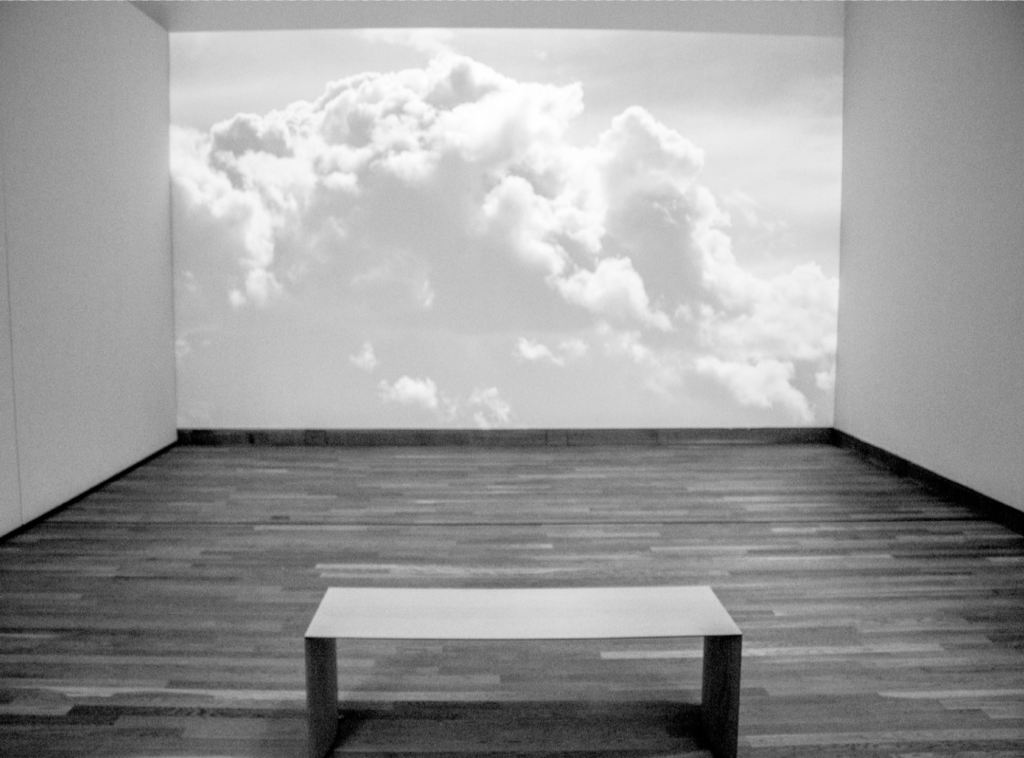Clouds, Temporarily Visible
Review by Sara Nichol
Weisman Art Museum
Jan 30–May 22, 2016

Clouds, Temporarily Visible, trivializes the ideas, movements, and relationships formed between viewer and artist by reducing what the artist is saying to the most insignificant aspect about each piece: its subject rather than its meaning, stalling any potential for conversation with a viewer.
Which is why, as a museum and as a learning institution, the Weisman Art Museum is such a disappointment to me. I want to look at that great Gehry riverfront monument and believe that its substance equates with the significance it touts.
This exhibit sells itself as playful, interactive, timeless, and suited to anyone who appreciates the beauty of these “these oft-watched, romanticized, and studied diaphanous formations.”1 I appreciate cloud gazing, but I want more.
The most eye-catching work in this exhibition, CLOUD by Caitlind r.c. Brown and Wayne Garret, greets visitors upon entry. A frame made of steel and chicken wire holds a sculpted cloud of recycled and functioning light bulbs overhead. Dangling pull-strings elicit a sense of nostalgic mechanism, encouraging viewers to tug, to turn on or off bulbs as though to enliven or darken collective thought above. I engage in this thought, and as I do, I’m aware of my position as a solo visitor to the space. Perhaps it’s my Minnesotan disposition, but I duck out repeatedly to make way for selfies and families. In a sense this feels similar to when you first enter the Weisman, where a few big pieces are unable to be taken in as a whole because they stand too close. This too is a sort of obstruction. I can’t help but think that opening an exhibit with an interactive component sets up the expectation that all the works to follow should catch my attention immediately, and require little more than the tugging of a string to be inspirational. Moreover, placing Brown and Garret’s work front and center in a show thematically centered on the solitary act of observation seems out of place.
There is no mention of the worlds of thought from which the works in this show arise. As an artist, I find it upsetting to know that my objectives and vision can be overlooked so blatantly. It is not enough to group together objects of depicted likeness with no regard to the context in which they are made, nor is it enough to ride upon the fame and fandom of big names and assume integrity or kinship by proximity. From where did these works and relationships arise? What social, artistic, historical worlds do they represent?
Spencer Finch’s Cumulus Humilis, one of the strongest pieces in the show, is made of Scotch tape, layered to create variable levels of opacity on a deep blue background. Cumulus Humilis is inscribed with the place it was made: Marfa, TX. This inscription deliberately calls out a relationship to Minimalism- Marfa, of course, being the site of Donald Judd’s retreat from the New York art world. This immediately prompts the viewer to consider the contemporary application of Minimalist ideals in a painterly fashion- the use of industrial materials, the use of solid color, the removal of the artist’s hand, the creation of pure forms, the structure of organic forms.
Two paintings by Jon Scheuler play a central role in the show. Mary Abbe’s review, Clouds Fill the Weisman in a Fun Show, which opens with the line, “Gods sit on them, scientists study them, poets rhapsodize and artists paint them”2 , is the perfect venue for talking about his work: phony, saccharine poetics.
When I was a student at the U of M during the Weisman’s latest expansion, I had the opportunity to speak with Lyndell King and I understand that the Weisman takes seriously its responsibility to educate. That said, there is room for deeper engagement. It’s hard to imagine the Weisman as a significant cultural institution when it struggles to relate and contextualize even the works in its own collection. I would love to see the Weisman as a dynamic institution connected to what is happening in the local- or even campus wide- arts community, yet fear this will never be possible until the Weisman can look beyond superficial beauty.
